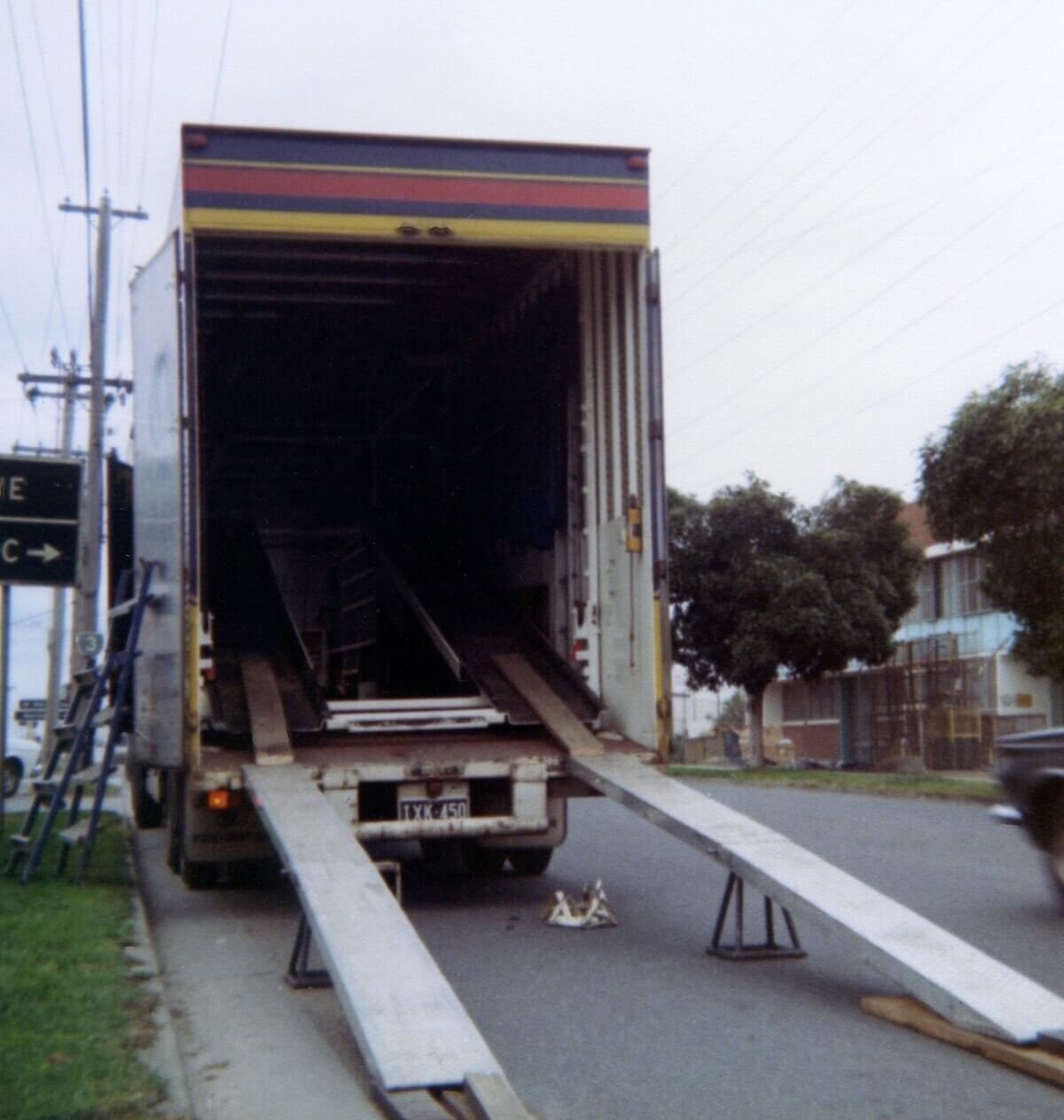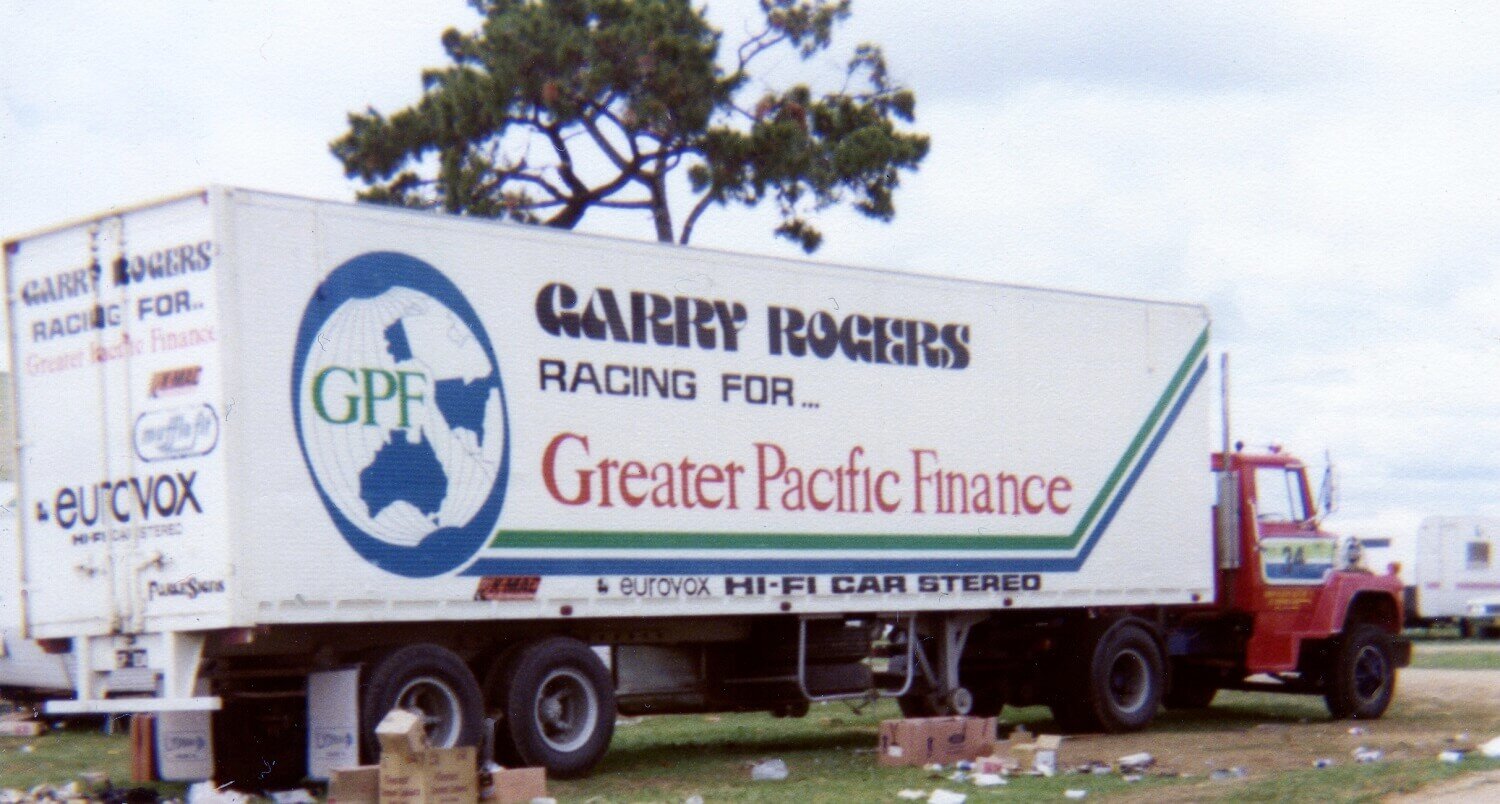THE FIRST OF THE BIG RIGS
Looking back at the early purpose-built race transporters in Australian touring car paddocks
Joe Sullivan with the Murray Carter Racing transporter at Surfers Paradise
Earlier this week, we wrote about Allan Moffat’s Racemobile GT International transporter that hit the road in 1974. It was built for motorsport and made a big impression in race paddocks. But what came before it? And where did race transporters go next?
In the early 1970s, a race transporter even half the size of today’s polished B-Doubles was rare. Some entrants drove their racing machinery to the circuit on public roads.
“I was looking at a photo recently of Murray Carter’s GTHO Falcon coming through the last corner at Bathurst in 1970, and that was actually the race car, and the race car transporter,” says Australian motorsport veteran, Joe Sullivan, who got his start with Murray Carter’s race team a few years later.
“Murray drove the car to the track. He didn’t have a truck or a trailer, so he just drove it on the road. He was a reserve for the 500-mile race back then, so the photo was when he was doing the practice sessions earlier in the weekend.”
Tray trucks, open trailers and volunteer crews
The predominant race transport solutions in the early seventies were either an open trailer behind a car or ute, or a tray truck with a race car on the back.
“The first transporter I had anything to do with driving was a D-Series Ford tray truck,” recalls Joe. “That was Murray Carter’s transporter at that stage. Prior to him getting it, it was Larry Ormsby’s Falcon GTHO transporter. He sold it to Murray, who used it from the start of the two-door Falcon era. That stayed as a tray truck in Murray’s stable for three or four years.
“Back then, only three or four people in the team would go to a race meeting, and possibly one or two people would fly depending on their work arrangements,” continues Joe. “A lot of the road trips were the full crew of people who went to the race meetings, and that was all we had for the weekend.
“Different people on the team would drive the transporter depending on who was available that weekend. I was working a full-time job in those days, so I didn’t go to all the race meetings. And truck driving and being a crew member wasn’t a paid job, that’s for sure!”
Ramping up the scale
The professionalism of motorsport was growing by the round in the mid-seventies, and the transporters were getting bigger each year.
“It really was the beginning of the era,” says Joe. “Bob Jane was a pioneer in using semi-trailer-style transporters and some others had started using purpose-built transporters such as Allan Moffat, but size-wise, Allan Grice and Murray Carter each brought some of the biggest transporters into the paddock, one after another.
“Gricey was before us. He used a transporter quite similar to ours before Murray acquired it. It was a caravan-style over the turntable with a raised area once it got to the back of the prime mover where the cars were. But it wasn’t full length and height.
Allan Grice’s race transporter in 1978
Thanks to Darryl Smith from Circle Work for this one.
“Murray then acquired the Ford Louisville, and from memory, we had the first full-sized trailer in the paddock in terms of length and width. That’s when motorsport became a full-time job for me, in the period when the touring car teams grew from one or two full-time people and started heading in the direction that we see today.
“When I look back, both Gricey’s and Murray’s transporters represent a ramping up of transporter-spec that’s continued to this day.”
New concepts in the paddock
We asked Joe about the features of the Murray Carter Racing transporter, and how it compared to the other rigs in that era.
“Inside, it was much more mechanical than today. It was a range of cables and ramps back in those days. Murray copied Gricey’s transporter with a hinge ramp type of arrangement to make it double storey.”
The rear of the Murray Carter Racing transporter in 1978
Photo: Joe Sullivan
Ramps down at the back of Murray’s race trailer the same year
Photo: Joe Sullivan
“There were varying arrangements of sleeping and eating and cooking, and the back part of the trailer was generally a workshop area and car storage,” continues Joe. “In Gricey’s case, they carried a small Suzuki-style ute, and there was room for about three vehicles and spares.”
A couple of big names also called their transporters home after a long day behind the wheel.
“Allan Grice and Allan Moffat also set the bar for a new concept with a lounge area and accommodation in the front. And in Gricey’s case, they actually used that for accommodation at the track for the whole race weekend. Dick Johnson, Allan Grice and Murray Carter would quite often sleep at the track after running all day. It was a reasonably brief period from what I can recall. Murray maintained it for quite a bit longer, but Gricey and Johnson generally stayed at hotels after that.”
Dick Johnson’s setup at Surfers Paradise in 1978
This photo was taken by Darryl Smith/Circle Work
Garry Rogers’ transporter at Bathurst in the late 1970s
Photo: Joe Sullivan
Three transporters in Tasmania in 1979, including the Holden Dealer Team rig
Photo: Joe Sullivan
The untapped potential of Australian motorsport
The ball was rolling, and dedicated race transporters have come a long way since.
“As these new transporters came in, it certainly lifted the vibe and spirit of the people around the touring cars,” recalls Joe.
“I probably saw it as untapped potential of what you could do with a touring car team. In turn, it also created some extra considerations around length and height limits that you didn’t have to contend with when it was just a ute and a trailer. But we found a way, and you can see where it’s ended up today.”
The Murray Carter Racing rig at Surfers Paradise in 1978
Photo Joe Sullivan
And so, that was how the big rigs emerged in the seventies. Thanks as always for your invaluable contributions, Joe, and to Darryl Smith from Circle Work for the Dick Johnson and Allan Grice transporter photos.
We’ve got one more Classics Week story to come with Joe tomorrow, and it’s a cracker, as his Murray Carter Racing rig grinds to a halt at the worst possible moment on a trip to Perth.








